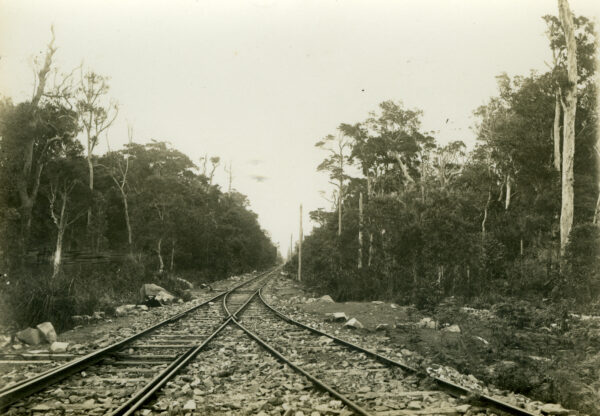Jock the Croc – The Crocodile that Became Famous
When the sand was being mined at Angourie beach in the 1930s, one Donald Rutledge, of Yamba, was employed by the Beach Mining Company as a locomotive driver on a light railway that ran to the company’s treatment works. On 30 November 1939, he was driving his train of empty trucks to the beach when he saw what he took to be a log lying near the line. He stopped the engine to investigate and was startled to see the log rise from the ground and reveal itself as an alligator or crocodile, about 5m in length. Thinking the huge reptile was about to charge the train, he started the engine and left in some haste. The report he made to police of this sighting sparked great excitement in the district and something of a media frenzy, especially after a police search found and took plaster casts of paw prints in the mud of a nearby swamp. These were sent to the Sydney Museum which stated it could be the left-hand paw of a crocodile about 3.66m long. Police Constable Jackson, who had spent several years in north Queensland and was familiar with the habits of crocodiles stated that, “The marks could not be made by any other animal I know of.”
Although there were no further sightings, the next few months saw many attempts to locate the crocodile. Locals started to report strange booming and bellowing noises from the swamp. Businessmen in Yamba offered a reward for the capture dead or alive of the crocodile as they feared its effect on tourism.
However, by Christmas various enterprising individuals were organising ‘crocodile hunts’ to attract and entertain visitors. One hunt killed forty-six snakes and several death adders and goannas. A number of swamps and water holes and burrows were dynamited. Swimming in the blue pool at Angourie Beach was banned. Another flushed out a large goanna which was killed, stuffed, and put on display at the Pacific Hotel as “The Angourie Croc”.

Zeitsch’s Cordial Factory in Grafton started producing a blue drink called “Crocodile Tears”, but this was soon withdrawn to avoid children confusing kerosene (also blue in colour) with cordial.
There was also much speculation on how the crocodile came to be so far south of its normal habitat. The most popular theory, that it was an escaped circus animal, was laid to rest when the bones of a known former circus crocodile were dug up. Fresh tracks found near the golf course were shown not to be from a crocodile but Billy Boney, referred to in the newspaper of the day as “King of the Clarence Valley Blacks”, left the area because of “too much crocodile.” He reasoned this way: “You meetem goanna, you stop, goanna run; you meetem crocodile, he stop, and you run. That difference”.
By March 1940 the Police Department had called off any further searches, but still suggested the council build a 1m wire netting fence around the Angourie Pool in case the crocodile moved there in the dry season.
The mystery of the Angourie Crocodile, aka ‘Jock the Croc’, remains in Yamba folklore. Sightings came to be attributed to “Wooloweyah Whisky” and the booming noise was attributed to a Bittern.
Songs and poems were composed about it and during the early 1940s it featured in Jacaranda parades and concerts (courtesy of George Weiley, a notorious prankster) and received a rousing reception! In 1954 it also appeared in a newspaper series on “Animal Mysteries of Australia “.
A bottle of the blue cordial, ‘Crocodile Tears’, is still kept in the Yamba Museum collection.
John McNamara and Sue Spence, Port of Yamba Historical Society